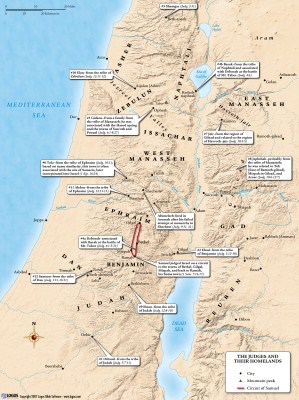12:1–7 This passage records a conflict between Jephthah and the Ephraimites after Jephthah’s victory over the Ammonites (see Judg 11:32–34). The encounter echoes Gideon’s experience when the Ephraimites challenged him after his victory over Midian (compare 8:1–3). While Gideon resolves the situation diplomatically, Jephthah does not. The incident at the crossing of the Jordan where the Ephraimites are identified by their accent is one of the few clear examples of linguistic variation between dialects of ancient Hebrew in the Bible (vv. 5–6). |
12:2 were engaged in great conflict with the Ammonites See 11:4–11.
you did not deliver me from their hand Jephthah claims that he did request help from the Ephraimites, but was denied. Chapter 11 records no such request, but Jephthah may have sent messengers as Gideon had (6:35; 7:24).
12:4 Jephthah gathered all the men of Gilead The situation degenerates quickly. Jephthah reassembles his army, which has just returned home. He is accustomed to solving problems with the sword, and this will be no exception.
You are fugitives of Ephraim, you Gileadites The Ephraimites accuse the Gileadites of being renegade, disloyal Ephraimites. This accusation carries an air of supremacy. Ephraim, as the leading tribe in the region, expected other tribes to do as they were told; thus, they intentionally cast Jephthah’s refusal as disloyalty to a superior.
of being renegade, disloyal Ephraimites. This accusation carries an air of supremacy. Ephraim, as the leading tribe in the region, expected other tribes to do as they were told; thus, they intentionally cast Jephthah’s refusal as disloyalty to a superior.
12:5 Gilead captured the fords of the Jordan In the parallel with the Gideon narrative, the Ephraimites secured these fords against the Midianites. Now, the Gileadites cut off an Ephraimite retreat.
12:6 say Shibboleth The Gileadites use differences of dialect as a test of identity. The Ephraimites were unable to properly articulate the sh of shibboleth. The Ephraimites likely could not even hear the distinction between shibboleth and sibboleth.
forty-two thousand from Ephraim fell An unusually high number, likely for reasons similar to those that produce the large numbers for the overall number of Israelites in our translations (see Num 1:46 and note).
 Large Numbers in the Exodus and Wilderness Journey
Large Numbers in the Exodus and Wilderness Journey
12:8–15 The three judges in this section—Ibzan, Elon, and Abdon—are among the so-called minor judges—judges about whom the biblical account gives little information. Mention of six minor judges brings the total number covered in the book to twelve (Judg 3:31l 10:1–5). It is unlikely, however, that these twelve were the only such figures during the period of the judges. The writer probably selected representative stories that well illustrated the conflict and chaos of the period. |
 Judges and Their Rule Table
Judges and Their Rule Table
12:9 thirty sons Like Jair (10:4), Ibzan has 30 sons.
12:10 was buried in Bethlehem Ibzan was either from the Bethlehem in Zebulun (Josh 19:15) or the one in Judah
(Josh 19:15) or the one in Judah (Judg 17:7; 19:1). It is uncertain which is in view here, but the other references to Bethlehem of Judah in the book of Judges explicitly mention that the location is in Judah (17:7; 19:1; compare Ruth 1:1). However, Judg 12:11 suggests an association with Zebulun.
(Judg 17:7; 19:1). It is uncertain which is in view here, but the other references to Bethlehem of Judah in the book of Judges explicitly mention that the location is in Judah (17:7; 19:1; compare Ruth 1:1). However, Judg 12:11 suggests an association with Zebulun.
12:13 Abdon the son of Hillel the Pirathonite One of David’s mighty men was also a Pirathonite (2 Sam 23:30).
12:14 that rode on seventy male donkeys Abdon was wealthy (see Judg 10:4).
12:15 Pirathon Located about six miles southwest of Shechem.
the Amalekites The reference to Amalekites suggests they had once lived in the region. The Amalekites were one of the Canaanite peoples occupying the land before Israel (Num 13:29; 14:43–45; Deut 25:17–19). They were a perennial enemy of Israel during the period of the judges (Judg 3:13; 6:3–5) and into the period of the monarchy (1 Sam 15:1–9; 2 Sam 1:1–16). They are usually associated with the Negev region south of Judah, but in Judg 6:33, they are part of a group from east of the Jordan, suggesting the Amalekites were semi-nomadic.
were one of the Canaanite peoples occupying the land before Israel (Num 13:29; 14:43–45; Deut 25:17–19). They were a perennial enemy of Israel during the period of the judges (Judg 3:13; 6:3–5) and into the period of the monarchy (1 Sam 15:1–9; 2 Sam 1:1–16). They are usually associated with the Negev region south of Judah, but in Judg 6:33, they are part of a group from east of the Jordan, suggesting the Amalekites were semi-nomadic.

|
About Faithlife Study BibleFaithlife Study Bible (FSB) is your guide to the ancient world of the Old and New Testaments, with study notes and articles that draw from a wide range of academic research. FSB helps you learn how to think about interpretation methods and issues so that you can gain a deeper understanding of the text. |
| Copyright |
Copyright 2012 Logos Bible Software. |
| Support Info | fsb |
 Loading…
Loading…
